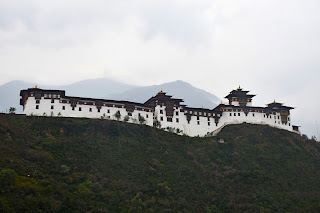Bhutan – Day 4: From Wangdue Phodrang to Jakar
Today was a major travel day: we had to make the seven-hour journey from Wangdue Phodrang to the city of Jakar in Bumthang District, the historic heart of Bhutan. Winding our way up and down the major artery that connects Thimphu to the central regions, we covered the 2000 metres of altitude that separate subtropical forests from the snowline. The change in flora was remarkable. In the lowlands, we spotted banana and papaya trees, whereas higher up, the lush green landscape gave way to forests of pines and rhododendrons. These grow to enormous heights in Bhutan, rivalling even the moss-festooned magnolia trees that often find themselves sprinkled in between.
Despite our assiduous
turning of prayer wheels for the past several days, it appears that our luck for
good weather has run out. Though occasionally scenic, the mist and clouds often
proved impenetrable obstacles to our observation of the landscape. Indeed, when
we reached the pass Pele-la at the height of 3420 metres, we could barely see
the chorten standing right at the roundabout, and the whirling snowflakes soon
chased us away. It was unbelievable that even at such a height, there were
still street vendors – albeit bundled up and sat around their rusty braziers.
As on any proper road
trip, we moved little and snacked a lot. At Pele-la, we bought dried yak cheese
cubes, which usually hang in garlands from the beams of roadside shacks. This
snack is known for being tough to the point of inedibility, but ours were still
quite manageable, even if culinarily unremarkable: yak cheese cubes taste more
of the fire above which they are dried than of cheese. Later on, we also
acquired some spicy vegetable slices and fried dough knots, both of which we
found quite tasty but very oily. Less oily but equally unhealthy were the
Malaysian ghost pepper crisps we acquired at a market near Trongsa; the soy
sauce used to flavour them gave the crisps a disquieting blackness.
We passed a few scenic
sights on our journey without making very long stops. Leaving Punakha, we drove
by Wangdue Phodrang Dzong, which towers majestically above the river, and which
can be accessed by an equally picturesque bridge. Then, after descending from
the Pele-la Pass, we made a short stop by a beautiful white stupa decorated
with the Buddha’s all-seeing eyes.
The major sight of the
day, however, was the Trongsa Dzong, the longest Dzong in Bhutan. Impressive
from both inside and outside, Trongsa Dzong has several towers, multiple
courtyards, and around a dozen temples. As it lies on a vital route connecting
Western and Central Bhutan, the Trongsa Dzong played a vital role in Bhutanese
history. It was from Trongsa that the first Wangchuk King conquered the rest of
Bhutan, including the holdout valleys of Thimphu and Paro.
The wood carvings and
paintings at Trongsa are remarkable. They include a beautiful depiction of
Padmasambhava’s heavenly palace and a very detailed bhavachakra. Our guide
described the iconography of the latter: the innermost white circle is
inscribed with a simple prayer, while the circle around it depicts three
animals: a hog, a snake, and a bird, each representing the most serious of sins
(greed, anger, and pride, respectively). Moving outward, the next circle
depicts the six ways one might be reincarnated: in hell, among the insatiable
spirits, as an animal, as a human, as a demi-god, or in paradise. Finally, the
outermost circle depicts the twelve phases of human life that bind us to
Samsara, the cycle of rebirth. The entire wheel is held by Yamaraja, the
fearsome God of Death, who is traditionally depicted with three eyes and a
tiara of skulls.
For the first time in
Bhutan, we also visited a shrine dedicated to Maitreya, the Buddha of the
Future. I learned that the tell-tale visual sign of this Buddha is that he
tends to be depicted sitting with his feet hanging down rather than
cross-legged. The temple seemed truly ancient. Unlike many others, its wooden
statues were worn down with age, and its many-coloured flags had turned quite
drab.
Despite our being waylaid by a herd of yaks on our way from another mountain pass (likely Yotongla Pass, which stands at the height of 3450 metres), we made it to our destination just in time for dinner. Our meals have luckily been mostly vegetarian – and very interesting. Reminding me of my days in Xishuangbanna, we have been served ferns quite a few times. Other plates tend to comprise seasonal vegetables like squash, chilli peppers, and various kinds of mushrooms.









































Comments
Post a Comment